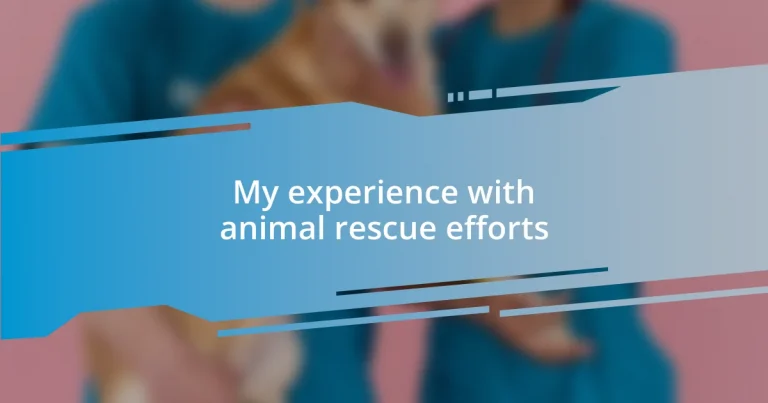Key takeaways:
- Understanding animal rescue needs involves addressing immediate care and implementing long-term solutions like spaying/neutering programs and community education.
- Building a supportive community and fostering collaborations enhance rescue efforts; strategies include engaging volunteers, public awareness campaigns, and leveraging social media.
- Celebrating success stories, such as successful adoptions, inspires others to participate in rescue efforts and highlights the positive impact of animal rescue on both animals and their new families.

Understanding animal rescue needs
When I first got involved in animal rescue, it struck me how overlooked many needs were, like proper medical care and safe shelter. I remember finding a stray dog in distress; it dawned on me just how many others were out there, waiting for someone to notice. Have you ever seen an animal in need and felt that urgent tug at your heartstrings?
Understanding these needs isn’t just about immediate rescue. It’s also about long-term solutions. For example, I’ve seen countless volunteers dedicate their time to spaying and neutering programs, which can drastically reduce the number of animals living on the streets. Isn’t it amazing how one act can create a ripple effect, ultimately leading to a healthier animal population?
Sometimes, I’m amazed at the sheer variety of support required—from fostering pets to educating the community about responsible pet ownership. I recall a heartwarming moment when a family adopted a rescued kitten, transforming their home and lives together. What could be more fulfilling than witnessing the joy that rescue animals can bring into our lives and homes?

Strategies for effective rescue efforts
When it comes to effective rescue efforts, a well-coordinated approach makes all the difference. I’ve seen firsthand how collaboration between local shelters and community members can amplify resources. One memorable experience was during a weekend outreach event where we set up a free veterinary clinic. The outpouring of support from volunteers and local businesses not only helped countless animals but also fostered a deeper connection within our community.
Here are some effective strategies for animal rescue:
- Building Community Partnerships: Collaborate with local organizations for resources and expertise.
- Engaging Volunteers: Create a training program that empowers volunteers to handle various rescue situations effectively.
- Public Awareness Campaigns: Host events to educate the community about spaying and neutering, responsible pet ownership, and the importance of rescue.
- Utilizing Social Media: Share success stories and urgent needs to reach a broader audience and inspire action.
- Fostering Relationships: Find committed foster families who can provide care and help rehabilitate animals before adoption.
In my journey, I’ve learned that every small step—like creating a flyer for a local event or sharing an inspiring story on social media—can lead to significant change. It’s about turning passion into action, and every effort counts, no matter how small it seems.

Building a supportive community
Building a supportive community is essential for the success of any animal rescue effort. I vividly remember one evening when I attended a town hall meeting, where passionate residents gathered to discuss how we could better support local rescues. It was heartwarming to see how a simple conversation sparked ideas for fundraising events and partnerships that ultimately benefited the animals in our care. Have you ever felt the energy of a group coming together for a shared cause?
As we continued brainstorming, I realized that everyone had something unique to offer. One neighbor, a retired veterinarian, volunteered his time to conduct workshops on pet care and first aid for animals. His knowledge empowered others, and we witnessed an increase in responsible pet ownership within our community. This experience truly reinforced the idea that when individuals come together, their collective strengths can create an incredible impact.
Moreover, I’ve found that online communities can be just as powerful as in-person ones. In a Facebook group dedicated to local rescue efforts, I’ve seen people rally support for animals in dire situations. I recall one particularly moving post where a volunteer urgently appealed for help to rehabilitate an injured stray. The swift response from the group members showcased how digital platforms can unite us, turning compassion into action in a matter of moments.
| Community Engagement | Impact |
|---|---|
| In-Person Meetings | Idea Generation and Networking |
| Workshops and Training | Empowering Community Members |
| Online Social Media Groups | Swift Support and Fundraising |

Volunteer roles in animal rescue
Volunteering in animal rescue encompasses a variety of rewarding roles that cater to different skills and interests. I remember my first time at a shelter, where I took on the task of socializing shy dogs. It was a transformative experience—the moment a nervous pup finally approached me for some affection was both exhilarating and heartwarming. Have you ever felt that connection ignite, knowing you played a part in helping an animal trust again?
Another crucial volunteer role is fostering. There was a period when I fostered a litter of kittens who had been separated from their mother. Each day, I watched them grow stronger and more curious about their surroundings. Witnessing their playful antics brought immeasurable joy, and it was astonishing to see the transformation of scared, timid souls into playful, loving companions ready for adoption. This role truly highlights the tangible impact of fostering—you’re not just providing a home; you’re shaping lives.
Education is also key in rescue efforts, and as a volunteer, I had the opportunity to lead workshops on responsible pet ownership. Engaging with community members about spaying and neutering opened up vital conversations. The look of realization on someone’s face when they understood how important these practices are made all the hard work feel worthwhile. Isn’t it rewarding to know that sharing knowledge can guide someone toward being a more responsible pet parent? Every role, no matter how big or small, contributes significantly to the overall mission of animal rescue.

Overcoming challenges in rescues
Overcoming challenges in animal rescue often requires not just persistence, but creativity. I vividly remember a rescue mission where a group of us was tasked with saving a family of stray dogs that were skittish and wary of humans. To approach them, we decided to set up a feeding station, using food to draw them in slowly. Have you ever experienced that mix of anxiety and hope as you wait for an animal to trust you? Watching those dogs gradually grow comfortable with our presence was a moment that truly illustrated the power of patience.
One of the toughest challenges I faced was navigating local regulations regarding animal rescues. I recall a particularly frustrating situation when we found a neglected horse but faced obstacles with the authorities. In those moments, my frustration grew, but it also ignited a fierce determination in me. I took it upon myself to research our rights and advocate tirelessly for the animals involved. Isn’t it incredible how challenges can sometimes fuel our resolve, pushing us to learn and fight for what’s right?
Sometimes, the emotional toll of rescue efforts becomes overwhelming. In another instance, I had to say goodbye to a beloved foster dog who found a forever home. My heart ached, but I understood that letting go was part of the process. I firmly believe these bittersweet moments showcase the duality of joy and sorrow in rescue work. How can we cherish those we help while staying strong enough to continue rescuing more? I’ve learned that reflection in these instances serves as a reminder of why I undertake this work—because every animal deserves a second chance.

Sharing success stories and impact
There’s something incredibly heartwarming about witnessing a rescue animal thrive in their new environment. I remember one particular cat named Whiskers who came to us after being found injured on the street. After weeks of care and rehabilitation, I was there when he took his first leap onto a sunny windowsill. Watching him bask in the sun, full of life and energy, made me realize the profound impact we can have on these animals. Isn’t it amazing how one small act of kindness can change a life forever?
Success stories often extend beyond individual animals; they ripple through the community. I was part of a recent adoption event where dozens of animals found their forever homes in just one day. The joy in the air was palpable as families met their new companions. It’s moments like these that affirm why I push through the hard days. The realization that not only are we saving animals, but we are also enhancing lives through companionship is incredibly uplifting. Why do I do this? Because I want others to feel that same joy too.
Every successful adoption isn’t just about the animal; it’s also about inspiring others to get involved. I once shared my story at a local community center, hoping to ignite a spark in someone to volunteer. Someone approached me later, expressing that my journey motivated them to start fostering. Hearing that one conversation could encourage another person to become part of the rescue effort was a reminder that our stories matter. Isn’t it true that when we share our passion, we not only celebrate our victories but also ignite change?














